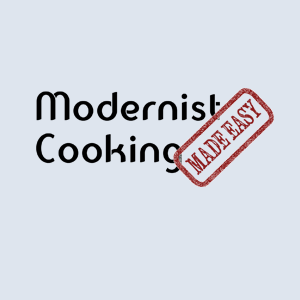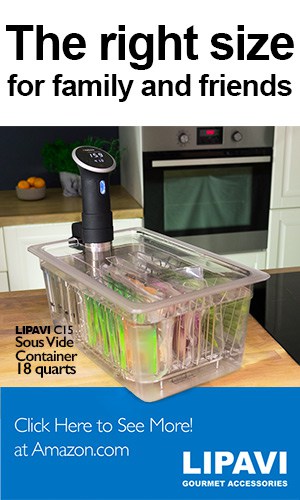-
Sous Vide Time and Temperatures
Sous Vide Time and Temps
Sous Vide Time and Temps
Sous Vide Temps
- All Sous Vide Temperatures
- Sous Vide Beef Temperatures
- Sous Vide Chicken Temperatures
- Sous Vide Duck Temperatures
- Sous Vide Fish Temperatures
- Sous Vide Vegetables Temperatures
- Sous Vide Infusions Temperatures
- Sous Vide Lamb Temperatures
- Sous Vide Pork Temperatures
- Sous Vide Shellfish Temperatures
- Sous Vide Turkey Temperatures
- Recipes Recipes Recipes Recipes
- Getting Started Guides Getting Started Guides Getting Started
- Equipment and Tools Equipment and Tools Equipment Equipment and Tools
- More Resources More Resources Resources More Resources
What is Sodium Alginate and How to Use it in Cooking
More Modernist Ingredients
•
Reverse Spherification • Sodium Alginate • Spherification
Click here to get great sous vide content via email
This post may contain affiliate links. Read more.
Written by Jason Logsdon

In many ways sodium alginate has become the poster child for modernist cooking due to its use in spherification.
Sodium alginate is a natural gelling agent taken from the cell walls of brown algae. However, it only gels when it comes in contact with calcium. Sodium alginate also has many uses other than spherification such as thickening, general gelling, and foaming. Whether or not you know it, each of us have eaten sodium alginate in many types of commercial foods such as ice cream or the pimento portion of stuffed cocktail olives!
Table of Contents
- What is Sodium Alginate Used For?
- Where to Buy Sodium Alginate?
- What is Sodium Alginate?
- How Do You Add Sodium Alginate To a Liquid?
- How Much Sodium Alginate to Use?
- Direct Spherification Versus Reverse Spherification
- How to Do Reverse Spherification with Sodium Alginate?
- How to Do Direct Spherification with Sodium Alginate?
- How to Make Caviar with Sodium Alginate?
What is Sodium Alginate Used For?Top
There are two main ways to use sodium alginate to create spheres. The first is direct spherification, where the sodium alginate is blended into a flavorful liquid, which is then added by the spoonful into a calcium lactate or calcium chloride bath. The second is reverse spherification, where the calcium is added to the flavorful liquid and then spoonfuls of the liquid are added to a sodium alginate bath.

Sodium alginate works best in non-acidic mixtures. If you are trying to use it in something acidic you can usually add sodium citrate to alter the pH before adding the sodium alginate. If you want to gel a thicker substance such as a puree, add water to thin it down until the mixture reaches a better liquid consistancy.
Sodium alginate also has many uses other than spherification such as thickening, general gelling, and foaming.
Where to Buy Sodium Alginate?Top
There are several places to purchase sodium alginate. We highly recommend ModernistPantry.com, they have great service and are really good to work with (because of this, we do have an affiliate relationship with them). They also have the Texturas brand called Algin, if you prefer that. You can also find it at WillPowder and get larger quantities and spherification bundles at ForTheGourmet.com.
What is Sodium Alginate?Top
Sodium alginate is a natural polysaccharide product that was first described in a patent application by the British chemist Edward C C Stanford in 1881. To this day brown algae are still the main source used to extract sodium alginate from. This group includes many of the seaweeds, like kelps, found in chilly northern seas. In addition to the food industry, the gelling properties of sodium alginate have been used in medical, dental and cosmetic applications for years.

How Do You Add Sodium Alginate To a Liquid?Top
In general, sodium alginate easily disperses, hydrates, and gels in any temperature of liquid and melts above 266°F (130°C).
However, it is easiest to add the sodium alginate powder little by little to the liquid, while mixing constantly with an immersion blender or whisk. If the alginate is not properly dispersed, small lumps will be visible in the solution. Try to avoid excessive whisking since the air bubbles can stay trapped in the thickened solution. In order to prevent these bubbles from complicating the spherification process, you may want to let the preparation settle in the refrigerator for a few hours.
How Much Sodium Alginate to Use?Top
The amount of sodium alginate you need to use depends a lot on the application you are using it for.
Amount of Sodium Alginate for Direct Spherification
For direct spherification a 0.5% to 1% sodium alginate base is used with a 0.5% to 1% calcium lactate setting bath. The more sodium alginate initially added to the base the higher the viscosity of the liquid inside the gel sphere.
- 0.5-1.0% sodium alginate base
- 0.5-1.0% calcium lactate bath
Amount of Sodium Alginate for Reverse Spherification
For reverse spherification a 1.0 to 3.0% calcium lactate base is used with a 0.4% to 0.5% sodium alginate bath. Note that the sodium alginate has now been added to the bath instead of to the base as in the direct spherification technique.
- 1.0-3.0% calcium lactate base
- 0.4-0.5% sodium alginate bath
Direct Spherification Versus Reverse SpherificationTop
The sodium alginate always gels, so in direct spherification the flavorful liquid gels inwards, while in reverse spherification the setting bath gels outwards from the liquid.

Reverse spherification is also made easier to master because you can first freeze the liquid in spheres before adding to the setting bath. It is easier to make perfect looking spheres when placing frozen flavored liquid base orbs instead of attempting to pour liquid droplet spheres directly into the setting bath.
Since the gelling process occurs on the outside of the liquid you also run no risk of gelling all the liquid, giving you more time before needing to serve them. Spheres created with reverse spherification can also be stored for longer periods of time so they are easier to make ahead of time.
Creating spheres with sodium alginate reverse spherification is a fun and surprisingly easy process! You can get more information about how spherification works and direct spherification vs reverse spherification.
How to Do Reverse Spherification with Sodium Alginate?Top
There are two components to spherification that you mix to create the spheres. The first is a flavored base liquid that will become spherified. The second component is a setting bath containing sodium alginate.

In reverse spherification you add calcium to the flavored base liquid you want to gel. The calcium is usually added in the form of calcium lactate or calcium chloride. Calcium lactate is almost always used in reverse spherification because it has a much more neutral taste than the bitterer calcium chloride. Once the calcium has been added you freeze the base in spherical or hemispherical molds.
Technically, you don't have to freeze the liquid to make the spheres; it just makes the process much easier. When frozen, the spheres have no chance to break apart. It also allows you to create spheres of a uniform size more easily.
Next, create the setting bath by combining water with 0.4% to 0.5% sodium alginate in a large bowl. Often sugar is added to this solution to incorporate some sweetness to the membrane that will form. The frozen spheres of base are then placed into the bath for 1 to 5 minutes, depending on the thickness of the membrane you want. Make sure the spheres are not touching or they will fuse together.
I recommend starting with one sphere at a time to test out some different setting lengths. That way you can see which one works best for your specific purpose. In general I've found:

- Small Spheres - 2 minutes
- Medium Spheres - 4 minutes
- Large Spheres - 5 minutes
- Thin Membrane - 1 minute
- Medium Membrane - 3 minutes
- Thick Membrane - 5 minutes
Once the membranes have set, the spheres are removed from the setting bath and placed in a plain water rinsing bath. This bath can be warm or cold, depending on the temperature you would like to serve the spheres. As soon as they are removed from the sodium alginate the membrane will stop forming.
These spheres can be served either cold or hot, up to about 266°F (130°C). Please be careful serving spheres at higher temperatures, if guests are expecting them to be cooler then they can get burned. You can also place the finished spheres into a whipping siphon, with some reserved calcium-free liquid, charge it, and let it sit for several hours to create carbonated spheres.
Storing the Spheres
The spheres can be stored for several hours or even overnight. However, the rinse water bath can leech out some of the flavor so they shouldn't be left in that water for more than 15 to 30 minutes. If you know you will be storing them for an extended period of time I recommend setting aside some of the liquid used in the flavored base, before the calcium is added, and storing the spheres in it.
Carbonated Spheres
You can also place the finished spheres into a whipping siphon, with some reserved calcium-free liquid. Charge it and let it sit for several hours to carbonate the spheres.
Reverse Spherification Ratios
For the flavored base a ratio of 1.0% to 3.0% calcium lactate is typically used with a setting bath of 0.4 to 0.5% sodium alginate.
Examples of Reverse Spherification Using Sodium Alginate
View additional reverse spherification recipes using sodium alginate, learn more about spherification techniques in general, or how to measure modernist ingredients for more information on ratios.How to Do Direct Spherification with Sodium Alginate?Top
I prefer reverse spherification for most applications but it does have its drawbacks, especially when it comes to creating small "caviar" beads. The beads will often stick to each other and clump so turning to direct spherification is usually much easier.

Direct spherification is a similar process to reverse spherification but the sodium alginate is added to the flavored base instead of the bath. This has a few effects, such as the membrane is made out of the flavored liquid instead of the setting bath, and the spheres must be served within 5 to 10 minutes because the membrane will continue to thicken even when they are out of the setting bath.
To get started with direct spherification you first combine the sodium alginate with a flavored liquid using a 0.5% to 1.0% ratio by weight. Then create the setting bath by mixing calcium into water. The calcium is usually added in the form of calcium lactate or calcium chloride at a 0.5% to 1.0% ratio. You can mix all of these at room temperature with an immersion blender.
Once you have the flavored sodium alginate base and calcium setting bath set up you are ready to start making spheres. First, fill two more bowls with plain water for rinsing. Then pour the flavored base, spoonful by spoonful, or drop by drop, into the setting bath. After 1 to 3 minutes the spheres are removed and placed in the bowls of rinse water. Serve them quickly because they will continue to gel due to the presence of the sodium alginate in the spheres.
Examples of Direct Spherification Recipes Using Sodium Alginate
View more sodium alginate direct spherification recipes, learn more about spherification techniques, or how to measure modernist ingredients for more information on ratios.How to Make Spherified Caviar with Sodium Alginate?Top
Caviar are just small spheres. Because spheres that touch stick together in reverse spherification, it isn't very effective for making them. Direct spherification is usually used.
Caviar Process
The initial steps to making caviar are the same as for making larger spheres. You first make the flavored base and mix in the gelling agent. Next, you prepare the setting bath with a calcium salt.
To make the caviar, drip the base into the setting bath and let them set for 30 to 90 seconds. Remove them from the setting bath and rinse them off before serving them. There are many ways to facilitate the dripping. You can use a plastic syringe, squeeze bottle, or eye dropper. Some people dip their finger tips in the liquid and lightly shake it off into the setting bath.
For larger quantities of caviar you can use a rapid caviar maker, which is a small box with 50 to 100 holes for the base to drip out of; this greatly speeding up the process.
Make sure you serve the caviar relatively quickly after making them because they will continue to gel as time goes on and will eventually become solid.
Caviar Ratios
The ratios for making caviar are the same for direct spherification.
Sodium Alginate
For caviar, a 0.5% to 1% sodium alginate base is used with a 0.5% to 1% calcium lactate setting bath.
Iota Carrageenan
For caviar, a 1% to 3% iota carrageenan base is used with a 4% to 6% calcium lactate setting bath.
Examples of Making Sodium Alginate Caviar
View more sodium alginate caviar recipes, learn more about how to use spherification techniques, or how to measure modernist ingredients for more information on ratios.Looking for More Articles?Top
- All Sodium Alginate Articles
- All Modernist Ingredients
- All Modernist Techniques
- My Modernist Recipes
- My Most Popular Articles
Sodium Alginate Recipes and Articles
Chipotle Caviar and Crispy Pulled Pork Recipe
 This recipe combines crispy pulled pork and savory deviled egg with a burst of spicy chipotle flavor into one of the more unique combinations. The crispy pulled pork can be used as a garnish for many dishes, and a topper for fish or salads.
This recipe combines crispy pulled pork and savory deviled egg with a burst of spicy chipotle flavor into one of the more unique combinations. The crispy pulled pork can be used as a garnish for many dishes, and a topper for fish or salads.
Melon Soup Spheres Recipe
 This recipe makes fresh cantaloupe and honeydew melons into a simple flavorful soup, then turns it into little spheres that my guests can pop into their mouths. By using a modernist spherification technique and the modernist ingredients of calcium lactate and sodium alginate, you too can make a fun take on this favorite summer food!
This recipe makes fresh cantaloupe and honeydew melons into a simple flavorful soup, then turns it into little spheres that my guests can pop into their mouths. By using a modernist spherification technique and the modernist ingredients of calcium lactate and sodium alginate, you too can make a fun take on this favorite summer food!
Chipotle Caviar Recipe
 Using miniature spheres, referred to as caviar, is a great way to add little bursts of flavor to dishes. Here we use a chipotle water but you can use the same technique on any liquid that doesn't contain calcium.
Using miniature spheres, referred to as caviar, is a great way to add little bursts of flavor to dishes. Here we use a chipotle water but you can use the same technique on any liquid that doesn't contain calcium.
Spherified Mango Ravioli Recipe
 One of the most interesting things in molecular gastronomy is spherification. Spherification is basically a process that seals a liquid in a jelly like membrane. There are several ways to accomplish this but in this article we will focus on the method of reverse spherification using calcium lactate and sodium alginate. When the calcium and the sodium alginate come in contact they form a membrane, encapsulating anything inside of it.
One of the most interesting things in molecular gastronomy is spherification. Spherification is basically a process that seals a liquid in a jelly like membrane. There are several ways to accomplish this but in this article we will focus on the method of reverse spherification using calcium lactate and sodium alginate. When the calcium and the sodium alginate come in contact they form a membrane, encapsulating anything inside of it.
 This article is by me, Jason Logsdon. I'm an adventurous home cook and professional blogger who loves to try new things, especially when it comes to cooking. I've explored everything from sous vide and whipping siphons to pressure cookers and blow torches; created foams, gels and spheres; made barrel aged cocktails and brewed beer. I have also written 10 cookbooks on modernist cooking and sous vide and I run the AmazingFoodMadeEasy.com website.
This article is by me, Jason Logsdon. I'm an adventurous home cook and professional blogger who loves to try new things, especially when it comes to cooking. I've explored everything from sous vide and whipping siphons to pressure cookers and blow torches; created foams, gels and spheres; made barrel aged cocktails and brewed beer. I have also written 10 cookbooks on modernist cooking and sous vide and I run the AmazingFoodMadeEasy.com website.
Affiliate Disclaimer: Some links on this site might be affiliate links that if used to purchased products I might receive money. I like money but I will not endorse something I don't believe in. Please feel free to directly go to any products I link to and bypass the referral link if you feel uncomfortable with me receiving funds.
















